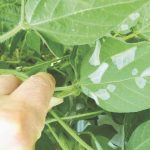
Features

Native insect acquires taste for soy
What's now called the soybean tentiform leafminer is moving north

Plan now for a farm’s future
FCC business advisor Tim Lang offers advice on what families need to consider in transition planning

Earlier-than-early seeding
These farmers use soil temperature, rather than the calendar, to time seeding wheat

Planting just one soybean variety is a ‘mistake’
Growers should try at least three, an Ontario soy expert says

Grain grading tools not just at the elevator
Learn how to assess what you have in the bin

Breeding picks up its pace
Thirteen years of testing, selecting and production now done in five

Window now wider, but ideal timing to plant soy still same
Risks also remain if pushing luck with planting depth and rates

Seeding rate may help manage flea beetle populations
A recent study investigated the effect of plant density on flea beetle populations in canola crops

The year in pulse crop inputs
A quick look at new actives, new combinations and expanded labels

Rebate roundup 2024
Cash-back rebates and rewards programs provide growers with much-needed certainty


